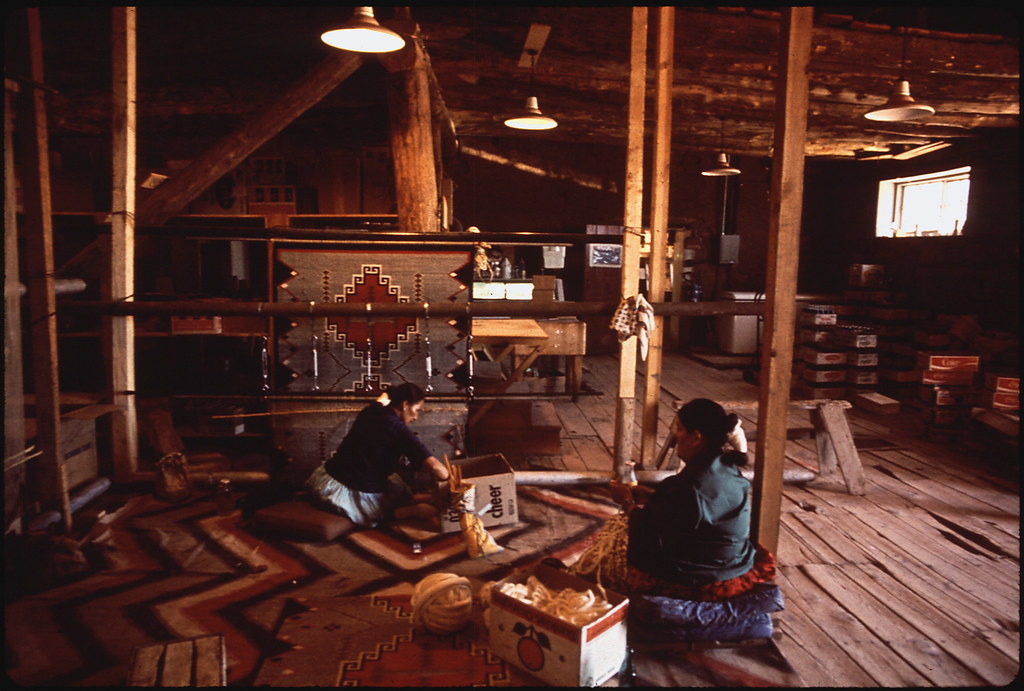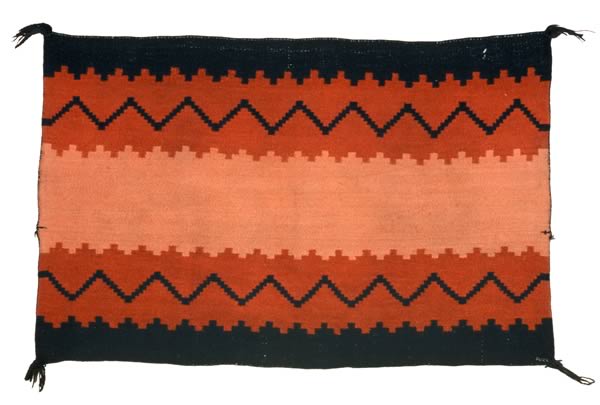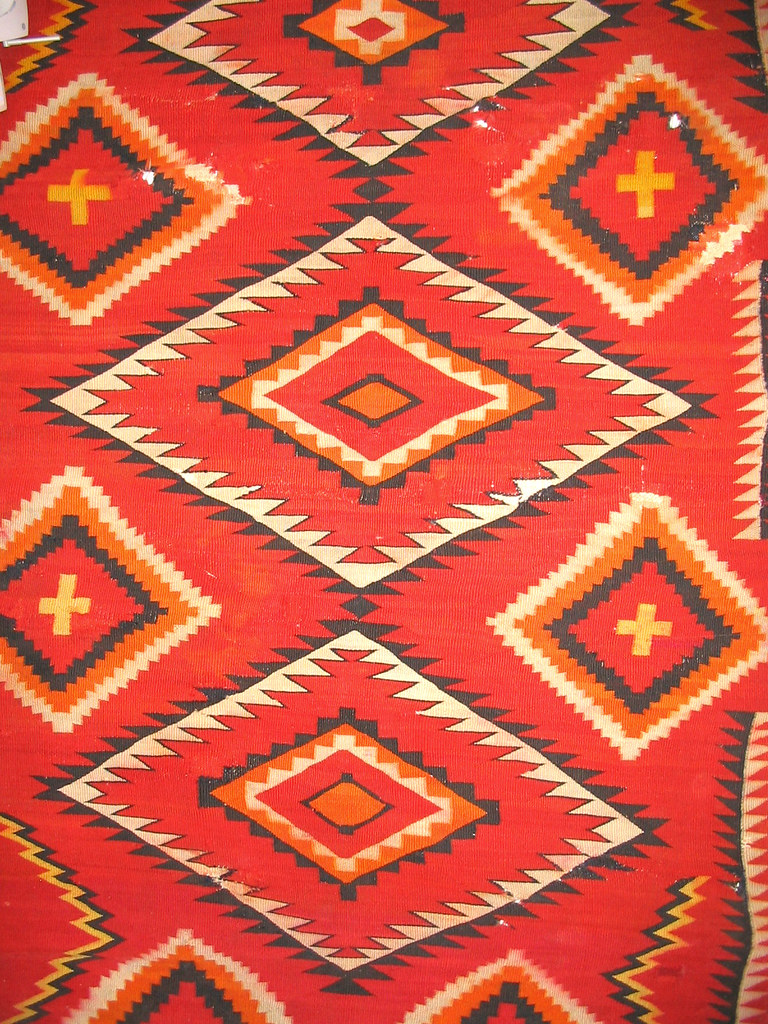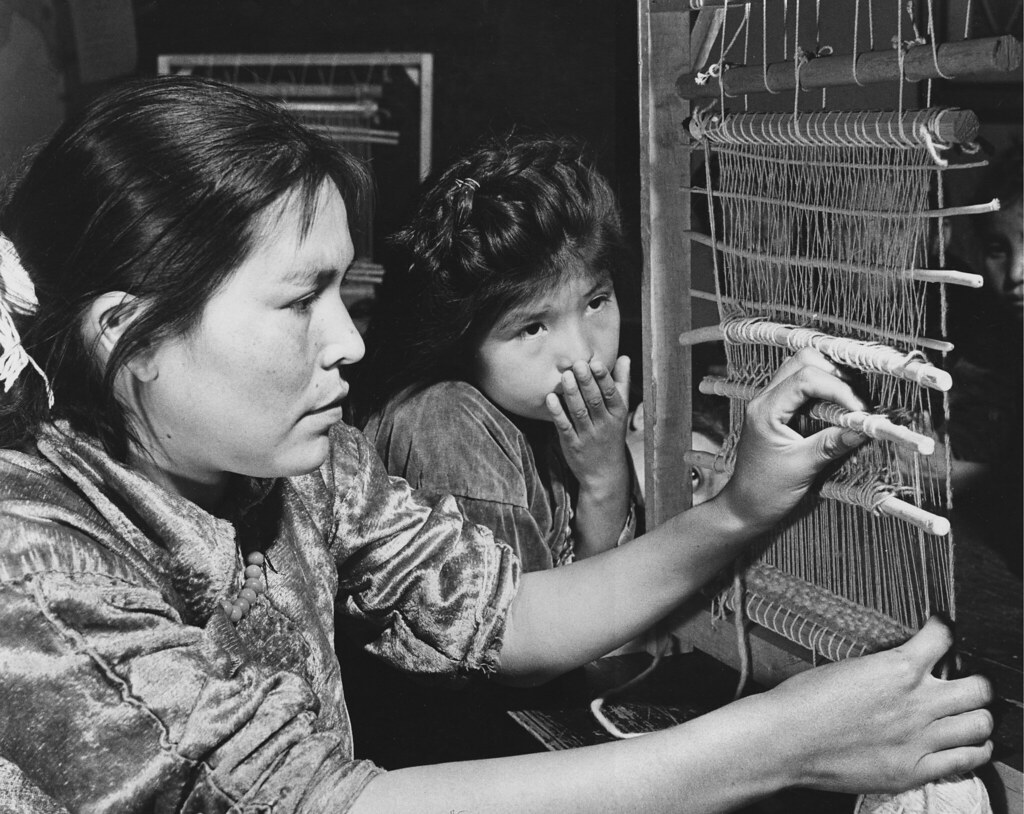.

Navajo Weavers At Hubbel Trading Post, the First Such Post on the Navajo Reservation, Ganado County, Arizona: photo by Terry Eiler for U.S. Environmental Protection Agency, May 1972 (National Archives and Records Administration)
Whatever man makes and makes it live
lives because of the life put into it.
A yard of India muslin is alive with Hindu life.
And a Navajo woman, weaving her rug in the pattern of her dream
must run the pattern out in a little break at the end
so that her soul can come out, back to her.
But in the odd pattern, like snake marks on the sand
it leaves its trail.
lives because of the life put into it.
A yard of India muslin is alive with Hindu life.
And a Navajo woman, weaving her rug in the pattern of her dream
must run the pattern out in a little break at the end
so that her soul can come out, back to her.
But in the odd pattern, like snake marks on the sand
it leaves its trail.
D. H. Lawrence: Whatever Man Makes, from Pansies, 1929

Woman's fancy manta, Navajo, c. 1850-1865: image by PDTillman, 2009 (Arizona State Museum)

Navajo blanket, 19th century: photo by George Wharton James, from Indian Blankets and their Makers, 1914

Transitional Navajo blanket, c. 1880-1895: photo by Flair Robinson Studio, 4 March 2009

Navajo Indian rug weaver with partially completed rug in loom, Southern Navajo Agency: photographer unknown, 1933 (Department of the Interior/Bureau of Indian Affairs/National Archives and Records Administration)

Spinning wool into yarn to be used in Navajo rug weaving, Southern Navajo Agency: photographer unknown, 1933 (Department of the Interior/Bureau of Indian Affairs/National Archives and Records Administration)
Navajo women weaving one of the very large rugs for which Southern Navajo (Ganado district) Indians are famous, Southern Navajo Agency: photographer unknown, 1933 (Department of the Interior/Bureau of Indian Affairs/National Archives and Records Administration)

Blanket weaver -- Navaho: photo by Edward W. Curtis (1868-1952), from The Apache; The Jicarillas; The Navaho [portfolio], Seattle, 1907 [Curtis caption: "The Navaho-land blanket looms are in evidence everywhere. In the winter months they are set up in the hogans, but during the summer they are erected outdoors under an improvised shelter, or, as in this case, beneath a tree. The simplicity of the loom and its product are here clearly shown, pictured in the early morning light under a large cottonwood."] (Northwestern University Library/Library of Congress)

Blanket weavers. Aboriginal life among the Navajoe Indians. Near old Fort Defiance, New Mexico: photo by Thomas H. O'Sullivan (1840-1882), 1873 (Library of Congress)

Navajo woman at loom weaving a blanket. A wooden crate that reads: "Charles Unsweetened Evaporated Milk" is near the woman. A herd of sheep walk on a ledge nearby. A stone and earth hogan is near the sheep: photo by William M. Pennington, between 1904 and 1932, from John Stewart MacCrary: "'Feel' of the desert", in The Desert Magazine, January 1940 (Library of Congress/ Western History/Genealogy Department, Denver Public Library)

Navajo woman weaver spinning wool into yarn at loom, Torreon, New Mexico: photo by John K Hillers (1843-1925), c. 1871-c.1907 (Smithsonian Institution. Bureau of American Ethnology/national Archives and Records Administration)

Navajo Rug Weaving: Kodachrome photo by Ray Manley, n.d ; original postcard caption: "From high in the sheep ranges of the Indian country come these pure wool masterpieces of the Navajo's rug weaving skill.Traditional Navajo weaving used upright looms with no moving parts. Support poles were traditionally constructed of wood although steel pipe is more common today. The artisan sits on the floor during weaving and wraps the finished portion of fabric underneath the loom as it grows. The average weaver takes anywhere from 2 months to many years to finish a single rug"; image by by Brenda (9teen87), 9 September 2011

Navajo girls learn first to weave by observation, near Navajo Mountain, Utah: photo by John Collier, 1948; image by John Collier, Junior, 11 November 2006

Navajo women weave a rug at the Hubbel Trading Post, first trading post on the Navajo Reservation: photo by Terry Eiler for U.S. Environmental Protection Agency, May 1972 (National Archives and Records Administration)




No comments:
Post a Comment